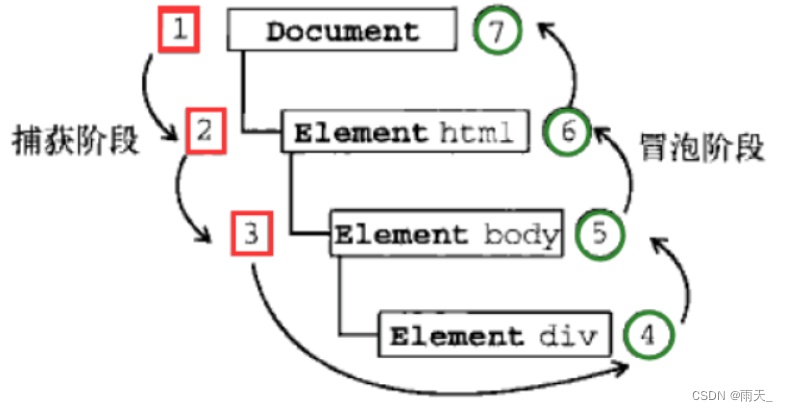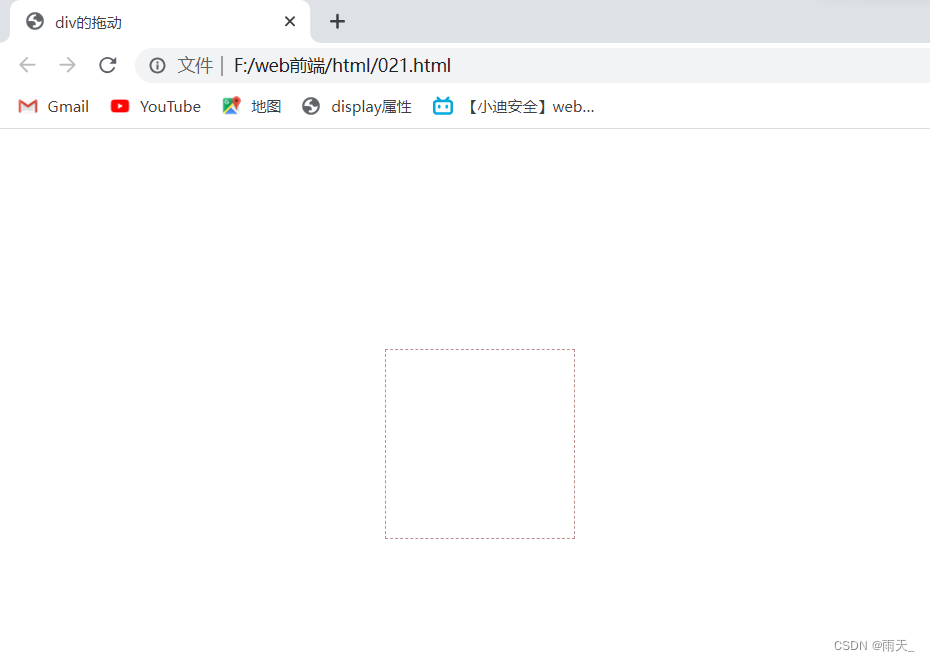js事件(event)
(js诞生就是基于事件驱动型编程)
(1)事件
用户通过各种行为(按键、鼠标点击、鼠标hover......)行为动作,引起相关 js 代码的执行。
事件的三元素:
- 事件源:事件的被触发者,一般会绑定事件
- 事件对象(event):这个对象包含了该事件相关的所有信息
- 事件处理函数:处理事件的代码

<1> 定义事件(三种方式)
[1] DOM0模式:需html的标签onxxxx属性来配置
缺点:耦合了js和html,违背了w3c的三层分离原则;这种方式在事件处理函数中,拿不到事件对象;事件函数中的this指针指向winodw对象
ps:
test01(this) // 绑定事件时,可以将this传递到事件函数中,事件函数需要传递这个this指针;
console.log(this) // 而在function中的this直接指向了window对象
<!DOCTYPE html>
<html lang="en">
<head>
<meta charset="UTF-8">
<meta http-equiv="X-UA-Compatible" content="IE=edge">
<meta name="viewport" content="width=device-width, initial-scale=1.0">
<script>
function test01(node){
alert("这里是美女,只不过你看不见")
}
// console.log(this);
console.log(node);
// node:事件源
</script>
<title>js事件</title>
</head>
<body>
<button onclick="test01(this);">点击一下,你就知道</button>
<!-- 双引号中,引入javascript代码 -->
</body>
</html>[2] DOM2模式
主要涉及到两个方法,用于处理指定和删除事件处理程序的操作:addEventListener()和 removeEventListener()。
- 通过DOM对象,动态绑定事件
<!DOCTYPE html>
<html lang="en">
<head>
<meta charset="UTF-8">
<meta http-equiv="X-UA-Compatible" content="IE=edge">
<meta name="viewport" content="width=device-width, initial-scale=1.0">
<title>DOM2</title>
</head>
<body>
<button id="box">美女不在这</button>
<a href="#" class="msg">可以在这找找看</a>
<a href="#" class="msg">可以在这找找看</a>
<a href="#" class="sss">你喜欢美女吗</a>
<a href="#" class="sss">你喜欢美女吗</a>
<a href="#" class="sss">你喜欢美女吗</a>
<a href="#" class="sss">你喜欢美女吗</a>
<script>
// DOM对象()
let box = document.getElementById("box");
// 通过DOM对象,动态绑定事件
box.onclick = function (ev){
// PS:动态绑定事件的方式,第一个参数就是事件对象
alert("那美女在哪?")
console.log(ev); // 事件对象
console.log(ev.target); // 事件源
console.log(this); // 事件源,这种事件中,this指向事件源
console.log(`x轴坐标${ev.pageX},y轴坐标${ev.pageY}`)
}
// 用className单个绑定,需确定下标
let msg = document.getElementsByClassName("msg");
console.log(msg);
msg[0].onclick = function(){
alert("这里也没有美女。")
}
// 多个同时绑定,需采用循环
let sss = document.getElementsByClassName("sss");
for(let i = 0;i < sss.length;i++){
sss[i].onclick = function(){
alert(`md,我喜欢的不得了,这是我第${i + 1}个按钮`);
}
}
</script>
</body>
</html>
- 还有一种事件监听方式,绑定事件
<!DOCTYPE html>
<html lang="en">
<head>
<meta charset="UTF-8">
<meta http-equiv="X-UA-Compatible" content="IE=edge">
<meta name="viewport" content="width=device-width, initial-scale=1.0">
<title>绑定事件</title>
</head>
<body>
<a href="http://www.baidu.com" id="go">百度</a>
<button id="box">这里有个祢豆子</button>
<script>
let box = document.getElementById("box");
// addEventListener:事件监听
box.addEventListener("click",function(e){
alert("点我干嘛");
console.log(this);
console.log(e.target);
// 这个方法会取消冒泡 IE浏览器
// e.cancelBubble();
// 停止标签继续向上冒泡(阻止冒泡) w3c
// ev.stopPropagation();
},true); // true:第三个参数true决定是否开启捕获流
document.querySelector("#go").onclick = function(ev){
alert("还是会去百度");
// 阻止标签的默认行为
ev.preventDefault();
}
</script>
</body>
</html>
[3] HTML事件处理程序
直接在HTML代码中添加事件处理程序
<input id= "btn" value= "按钮" type= "button" onclick= "showmsg();" >
<script>
function showmsg(){
alert( "HTML添加事件处理" );
}
</script><2> 事件流的分类

冒泡流:冒泡即事件最开始由最具体的元素(文档中嵌套层次最深的那个节点)接收,然后逐级向上传播至最不具体的节点(文档)
捕获流:捕获即事件最早由不太具体的节点接收,而最具体的节点最后接收到事件。
(2)常见的事件
| 事件 | 内容 |
| onabort | 图像加载被中断 |
| onblur | 元素失去焦点 |
| onchange | 用户改变域内容 |
| ondblclick | 鼠标双击某个对象 |
| onerror | 当加载文档或图像时发生某个错误 |
| onfocus | 元素获得焦点 |
| onkeydown | 某个键盘的键被按下 |
| onkeypress | 某个键盘的键被按下或按住 |
| onkeyup | 某个键盘的键被松开 |
| onload | 某个页面或图像完成加载 |
| onmousedown | 某个鼠标按键被按下 |
| onmousemove | 鼠标被移动 |
| onmouseout | 鼠标从某元素被移开 |
| onmouseover | 鼠标被移到某元素之上 |
| onmouseup | 某个鼠标按键被松开 |
| onreset | 重置按钮被点击 |
| onresize | 窗口或框架被调整尺寸 |
| onselect | 文本被选定 |
| onsubmit | 提交按钮被点击 |
| onunload | 用户退出页面 |
(3)代码示例:
例1:抽奖
<!DOCTYPE html>
<html lang="en">
<head>
<meta charset="UTF-8">
<meta http-equiv="X-UA-Compatible" content="IE=edge">
<meta name="viewport" content="width=device-width, initial-scale=1.0">
<style >
* {
margin: 0;
padding: 0;
}
.container {
width: 800px;
height: 800px;
border: 1px dashed rebeccapurple;
position: absolute;
left: 50%;
margin-left: -400px;
text-align: center;
line-height: 100px;
}
.container .box, .box2 {
width: 300px;
height: 300px;
background: greenyellow;
border-radius: 50%;
margin: auto;
margin-top: 50px;
text-align: center;
line-height: 300px;
}
.box2 {
background: deepskyblue;
}
#show {
font-size: 30px;
color: white;
font-weight: bold;
}
#start {
width: 300px;
height: 50px;
background: palegreen;
}
</style>
<title>抽奖</title>
</head>
<body>
<div class="container">
<div class="box" id="box">
<span id="show">
小礼品
</span>
</div>
<button id="start" onclick="start()">点击开始</button>
</div>
<script>
let start = document.querySelector("#start");
let show = document.querySelector("#show");
let timer = null;
let box = document.querySelector("#box");
let isStop = false;
let nums = ["iphone14","100w","1000w","杯子","大花棉袄","充电宝","欠我五元","谢谢惠顾"];
start.onclick = function(){
if(!isStop){
isStop = true;
timer = setInterval(function(){
let index = Math.floor(Math.random()*nums.length);
show.innerHTML = nums[index];
box.className = "box2";
start.textContent = "停止抽奖";
},100);
} else{
isStop = false;
window.clearInterval(timer);
box.className = "box";
start.textContent = "开始抽奖";
}
}
</script>
</body>
</html>
例2:div的拖动
<!DOCTYPE html>
<html lang="en">
<head>
<meta charset="UTF-8">
<meta http-equiv="X-UA-Compatible" content="IE=edge">
<meta name="viewport" content="width=device-width, initial-scale=1.0">
<style>
.box{
width: 150px;
height: 150px;
border: 1px dashed rosybrown;
position: absolute; /* 进行绝对定位 */
left: 300px;
top: 200px;
}
</style>
<title>div的拖动</title>
</head>
<body>
<div class="box"></div>
<script>
let _box = document.querySelector(".box");
_box.onmousedown = function(e){
let x = e.pageX-_box.offsetLeft;
let y = e.pageY-_box.offsetTop;
document.onmousemove = function(ev){
let x2 = ev.pageX - x;
let y2 = ev.pageY - y;
_box.style.left = x2 + "px";
_box.style.top = y2 + "px";
}
}
_box.onmouseup = function(){
document.onmousemove = null;
}
</script>
</body>
</html>